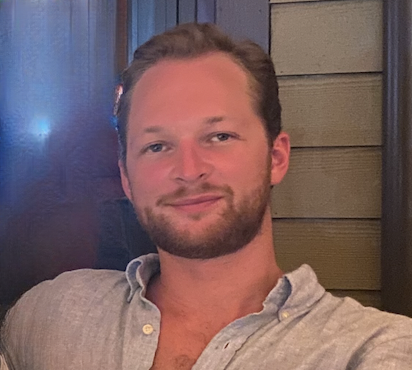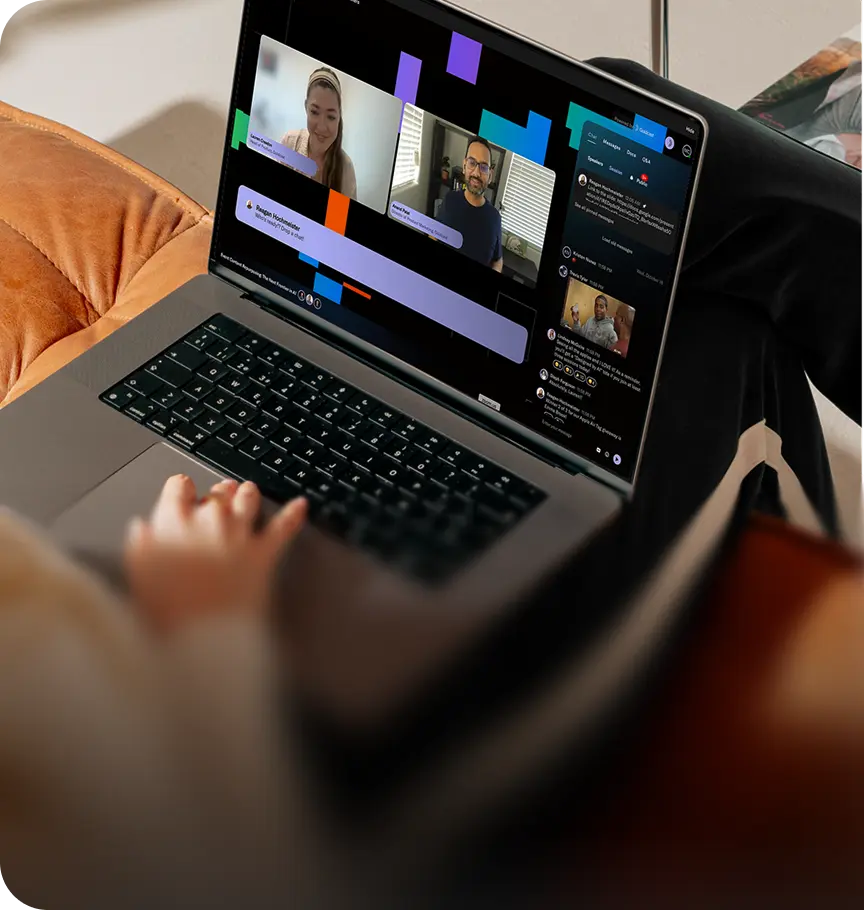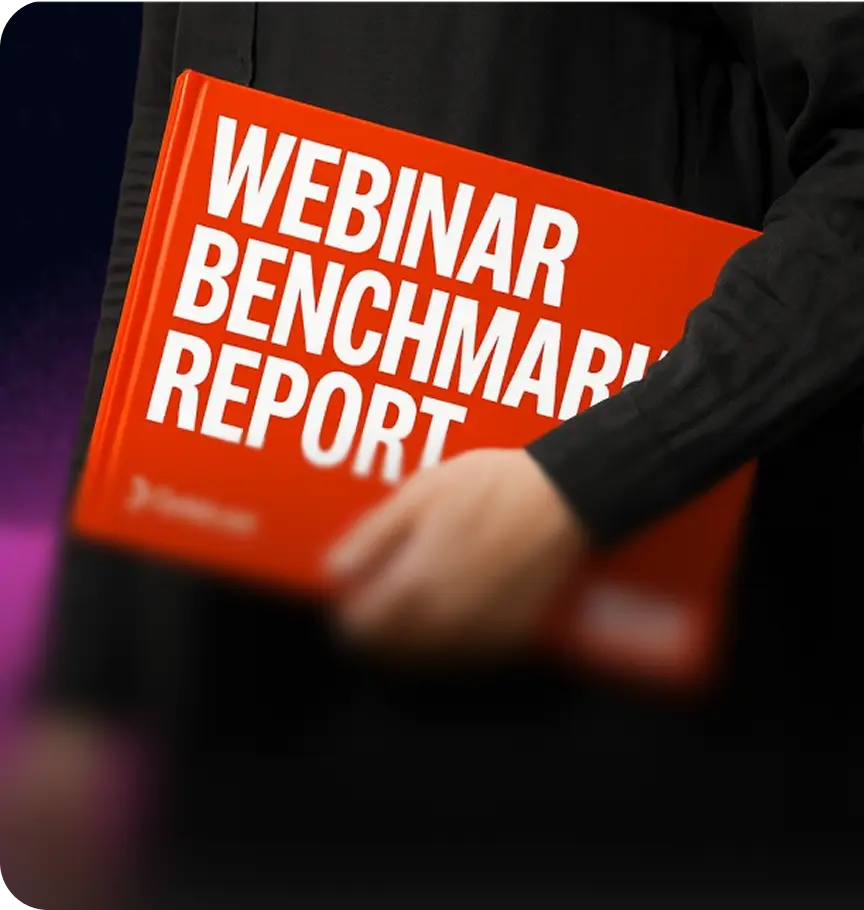How to Record a Video Podcast: The Complete B2B Guide

Table of Contents
Maximize Your Marketing ROI
Join 10,000 other marketers already getting the best tips on running engaging events that boost pipeline and create raving fans.
Most of us remember when podcasts were an audio-only medium, but today's audience want to hear and see podcast content. YouTube is now the top podcast platform, surpassing traditional audio-only options. This makes it clear that if you're serious about growing your podcast, you'll need to start creating video content.
Both beginners and experienced content creators struggle with this shift to video. While it's an incredible opportunity to build authority, capture attention, and drive business outcomes, there are new challenges involved. The technical side of video production is intimidating: What camera to get? Is the lighting right? What's the best recording platform? Does video editing need to be outsourced?
We have good news: These challenges are not insurmountable, especially with the help of AI. When you get past the scary technical stuff, you'll see that video podcasts allow you to scale your recordings into multiple other types of content, powering multi-channel content workflows that build lasting Mindshare.
Today we'll provide a comprehensive, step-by-step tutorial on:
- Why you should invest in a video podcast
- The basics of video podcasting
- Setup and repurposing tips
- How podcasts build Mindshare
Why video podcasts are worth the effort
B2B audiences are coming to expect visual content from brands; videos in particular build trust and establish human connection in a way that other mediums can't. People just respond to videos more viscerally than other types of content.
Adding video to your audio podcast makes your podcast more discoverable, more engaging, and more repurpose-able than an audio-only show. You're already putting in the hard work to come up with topics, write podcast scripts, and record the podcast audio — why not take it a step further and grab a video while you're at it?
Here are some of the key strategic advantages of adding video to your podcast:
Discoverability on video-first platforms (YouTube, LinkedIn, TikTok)
YouTube is the top podcast platform, and it's also the world's second-largest search engine, with algorithms that prioritize video content. We also know that LinkedIn is boosting video content, and TikTok is obviously a visual platform — so upload your videos to all of them to reach a bigger audience.
Human connection and trust-building
Video podcasts create stronger audience connections than audio alone. When viewers can see your facial expressions, body language, and real-time reactions to things, they start to feel like they know you. They begin to trust you. That trust directly translates into business impact and Mindshare — you're on people's minds when it's time to make a purchase decision because they've seen so much of you.
The repurposing multiplier effect
Recording video alongside your podcast unlocks exponential content repurposing opportunities. Sure, you can turn an audio recording into several different audio clips or audiograms, but a single 45-minute video conversation can generate dozens — if not more — of video clips you can use on social, in email campaigns, and elsewhere!
Editing software tools like Content Lab take your video recording and turn it into blog post drafts, email newsletters, social posts in your brand voice, and more. This helps you get the most out of the time you invest into producing and recording your podcast.
The bottom line: Video podcasts cut through the noise. Anyone can write a LinkedIn update or a quick blog post. It's consistently sharing your branded videos, over time, that establishes authority in a way competitors can't easily replicate.
Video podcast recording basics
Audio quality is the foundation of any great podcast episode. Even though we're adding video, we won't be sacrificing on audio! You also don't have to spend a ton of money on fancy, new video editing software to get a quality visual result.
Here's how to make sure your bases are covered:
Think audio first
Quality podcast equipment like a solid mic ensures that people can clearly hear and understand you. If you're on a budget, a USB microphone like the Audio-Technica ATR2500x or the Samson Q2U works well; these two plug-and-play options clock in around $100 and provide broadcast-quality sound without additional equipment.
As your own podcast grows, consider investing in an audio interface like the Focusrite Scarlett series and a dynamic microphone with voice-changing abilities like the Electro-Voice RE20. If you'd like to take it even further with sound effects and mixing capabilities, look into the PreSonus StudioLive.
You can also improve sound quality by incorporating soft furnishings and acoustic panels into your recording space; the emptier your space is, the more surface that your sound has to bounce off of.
Video gear options
You have a handful of video options, and the one you choose will depend on your budget, podcast format, and technical skills.
Lighting > lenses
The lighting in your recording area goes further than an expensive camera upgrade. Opt for a three-point lighting setup, which uses a main light source (called the "Key light") placed at a 45-degree angle to you, a "Fill light: directly opposite the Key light, and a "Backlight" behind you.
Ring lights are a budget-friendly option, although they do create circles in the subject's eyes, which many people don't like. You can experiment with softbox lights, all-in-one solutions, or LED panels for more natural-looking illumination, and try to incorporate natural light whenever possible.
Create a comfortable recording environment
Because people will be able to see into your recording space, you want it to reflect favorably on you. A cluttered environment distracts from your message and hurts credibility. Instead, keep things clean and streamlined, and consider adding a branded backdrop to reinforce your company identity.
Accessibility and compliance basics
Address accessibility from the start. Plan to provide captions and full transcripts for every episode (this also builds SEO!) and ensure your on-screen text is legible and accurate. You'll also want to verify you're in compliance with any necessary music or sound licenses, as well as guest consent and release forms.
Match your setup to your show format
It's important that the setup you choose aligns with your show format; not all podcasts require the same equipment or workflows. For a solo podcast setup, keep it simple. You want equipment that's easy to use, and a single webcam and USB mic set usually does the trick.
When you're recording multiple co-hosts together in person, you'll need more than just a webcam. Look into products like the Focusrite 18i8, which make group recordings manageable. Video coverage can include a single, wide-angle camera or you can try multiple cameras throughout the space, and then edit clips together at the end.
Many podcasters are recording remotely at this point, which is convenient but presents the most technical challenges since you can't control your guest's equipment or environment. Browser-based recording software like Recording Studio capture locally on each participant's device, bypassing potential connection issues.
Streamline Your Video Podcast Workflow
See how Goldcast Recording Studio's local HD capture and text-based editing can transform your content creation process in just minutes.
Recording tips to avoid post-production headaches
Now that you've got your setup in place, here's how to get a solid recording.
Local multi-track recording = your insurance policy
This is the single most important way podcast hosts can protect against quality issues! Without local recording, internet connectivity issues can destroy your podcast episode. Look for a platform that saves each person's audio files and video files directly to their respective devices, creating backup copies.
Multi-track recording also captures each speaker on separate audio files, allowing you to fine-tune during the editing process.
Sync and backup strategies
Ever watched a show where the actors' mouths are moving at a different pace than the audio? That is called sync drift, and it's something we obviously want to avoid with your podcast recording.
To avoid this, try the "clap slate." Clap your hands visibly in front of the camera before the conversation starts. Then, during editing, you can locate that frame and be sure that audio and video are perfectly aligned from that point on.
Other tips here: Use consistent frame rates across all recording devices, and be sure to back up throughout the recording process. Again, browser-based platforms save directly to your computer, which is great.
Remote recording workflow management
Clearly communicate with guests before the episode. If they'd feel more comfortable doing a dry run, schedule one, or at least let them log on early to get comfortable with the software. Send questions in advance, along with recommendations for microphones, headphones, browser choice, lighting, and anything else you want guests to know.
Network and bandwidth optimization
Reliable connectivity is as important as a good camera and microphones.
Things to remember:
- Set a minimum upload speed per guest (at least 5-10 Mbps).
- Prioritize wired Ethernet connections over WiFi when possible.
- Try not to run recording sessions through shared corporate VPNs, which can throttle bandwidth and introduce latency.
- Ask guests to disable automatic cloud backups (like Dropbox) and close big applications during recording to free up resources.
Even if bandwidth does dip, Recording Studio ensures everyone's audio and video are preserved at full quality. We've got you! And while, yes, there are free recording options out there, they're also quite restrictive — Zoom cuts group recordings off right at 40 minutes, and StreamYard adds watermarks to the free recordings, just to name a couple of examples.
Build Mindshare through your video podcast
Intentionally design your episodes to maximize recall and brand awareness; you can think of this as a Mindshare-first recording process. When you center Mindshare in your recording efforts, you ensure that each episode helps keep your brand top-of-mind for prospects.
Here are some ways to achieve Mindshare:
Use recurring branded elements
Consistent opening music, taglines, visuals, and introductions anchor your show for listeners and reinforce your brand identity. Think of the McDonald's golden arches; the more you saw them, the more they became etched into your memory. Your recurring elements function in the same way.
Ask signature guest questions
Consider asking one or more of the same questions for every guest. This generates pre-scripted repurposing opportunities that you can splice together later into fun compilations, and it also gives listeners something they can look forward to each episode.
You might even brand these all on their own; for example, if you ask people for a hot take, maybe you call it the "Hot Take Minute."
Rely on consistent CTAs
Repeating the same CTAs across episodes works like its own brand slogan, increasing listener recall. Use identical language for your calls to action, and hone in on the most important actions you want listeners to take.
Engineer brand recall over time
Select a publishing cadence you can keep up with, whether it's weekly, bi-monthly, or something else. Then, keep your branded intro/outro, your signature questions, and your CTA phrasing the same for at least six episodes before you make any changes. That gives people a chance to get comfortable with you.
Recording with Mindshare in mind creates memory hooks, simplifies repurposing, and strengthens your podcast's link to pipeline. Goldcast Recording Studio makes it easy to create high-quality video podcast recordings, while Content Lab automatically turns each recording into social clips, blog posts, and nurture assets.
From recording to repurposing and beyond with Goldcast
When it comes to video podcasting, true ROI emerges when you repurpose your videos into content that multiplies your reach across platforms.
Repurposing through an AI-enabled platform allows you to take one video and turn it into:
- Short-form social media clips for LinkedIn, TikTok, YouTube Shorts, and other platforms
- Blog posts that capture search traffic
- Email newsletters that keep content on people's minds
- Key takeaways you can share with your team
- …and more
With Content Lab, all of the above assets are generated in just a few moments, saving you tons of time and resources!
Recording a video podcast is a great way to build a scalable content system — and you can make it all happen in Goldcast. Start by recording in Recording Studio, then repurpose via Content Lab, and measure performance afterward with our Analytics suite and Integrations.
See How Goldcast Works
Discover how Recording Studio and Content Lab work together to turn one recording session into weeks of branded marketing materials across every channel.
Video podcast FAQs
Do I need multiple cameras for a professional-looking video podcast?
Nope! A single, well-positioned camera with good lighting produces great results.
What's the easiest way to record remote guests without sacrificing quality?
Use browser-based platforms with local recording capabilities, like Goldcast Recording Studio, which captures high-quality audio and video on each device and bypasses internet connection issues that plague video conferencing tools.
How do I mark "clip-worthy" moments during recording?
Keep a Run of Show handy as you record, and make a note each time something memorable happens. Goldcast Content Lab also analyzes your recording afterward for any key moments.
Should I record live or pre-record and edit?
Pre-record unless your format specifically benefits from live interaction. Pre-recording allows quality control, editing flexibility, and reduces technical risk while maintaining professional standards.
How do I avoid sync issues between tracks?
Start with a synchronized countdown, maintain consistent frame rates across devices, and use local recording platforms that automatically handle synchronization.
What's the best way to brand a video podcast visually?
Use consistent colors, typography, and logo placement. Clean designs work better across platforms and repurpose more effectively than complex graphics.
How do I make editing faster if I'm not a professional editor?
Text-based editing platforms like Goldcast Recording Studio make it easy to DIY your edits; you'll feel like you're editing a document, which is more intuitive!
How can I connect my video podcast to business outcomes like leads or pipeline?
Track specific CTAs within episodes through unique landing pages or campaign codes and monitor which episodes correlate with increased website traffic, demo requests, or sales conversations.
What metrics actually matter when measuring video podcast success?
Focus on engagement metrics like watch time, completion rates, and repeat viewership; you should also track downstream conversions from podcast traffic to measure business impact.
Transform Your Video Marketing with AI
Stay In Touch
Platform
Resources
© 2025 Copyright Goldcast, Inc. All rights reserved.





 Upcoming Events
Upcoming Events Event Series
Event Series On-Demand Events
On-Demand Events

